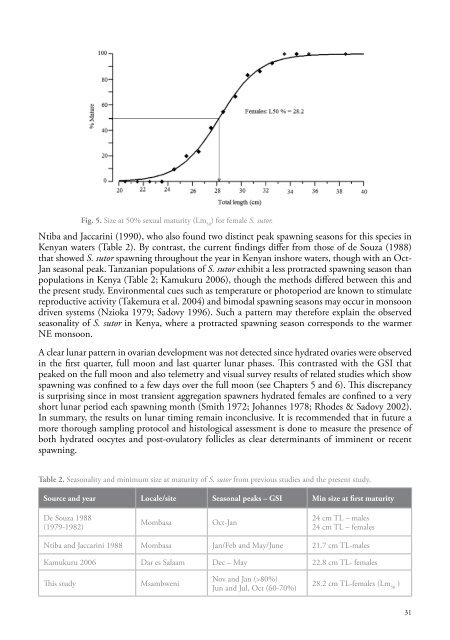WIOMSA-CORDIO spawning book Full Doc 10 oct 13.pdf
WIOMSA-CORDIO spawning book Full Doc 10 oct 13.pdf
WIOMSA-CORDIO spawning book Full Doc 10 oct 13.pdf
You also want an ePaper? Increase the reach of your titles
YUMPU automatically turns print PDFs into web optimized ePapers that Google loves.
Fig. 5. Size at 50% sexual maturity (Lm 50) for female S. sutor.Ntiba and Jaccarini (1990), who also found two distinct peak <strong>spawning</strong> seasons for this species inKenyan waters (Table 2). By contrast, the current findings differ from those of de Souza (1988)that showed S. sutor <strong>spawning</strong> throughout the year in Kenyan inshore waters, though with an Oct-Jan seasonal peak. Tanzanian populations of S. sutor exhibit a less protracted <strong>spawning</strong> season thanpopulations in Kenya (Table 2; Kamukuru 2006), though the methods differed between this andthe present study. Environmental cues such as temperature or photoperiod are known to stimulatereproductive activity (Takemura et al. 2004) and bimodal <strong>spawning</strong> seasons may occur in monsoondriven systems (Nzioka 1979; Sadovy 1996). Such a pattern may therefore explain the observedseasonality of S. sutor in Kenya, where a protracted <strong>spawning</strong> season corresponds to the warmerNE monsoon.A clear lunar pattern in ovarian development was not detected since hydrated ovaries were observedin the first quarter, full moon and last quarter lunar phases. This contrasted with the GSI thatpeaked on the full moon and also telemetry and visual survey results of related studies which show<strong>spawning</strong> was confined to a few days over the full moon (see Chapters 5 and 6). This discrepancyis surprising since in most transient aggregation spawners hydrated females are confined to a veryshort lunar period each <strong>spawning</strong> month (Smith 1972; Johannes 1978; Rhodes & Sadovy 2002).In summary, the results on lunar timing remain inconclusive. It is recommended that in future amore thorough sampling protocol and histological assessment is done to measure the presence ofboth hydrated oocytes and post-ovulatory follicles as clear determinants of imminent or recent<strong>spawning</strong>.Table 2. Seasonality and minimum size at maturity of S. sutor from previous studies and the present study.Source and year Locale/site Seasonal peaks – GSI Min size at first maturityDe Souza 1988(1979-1982)MombasaOct-Jan24 cm TL – males24 cm TL – femalesNtiba and Jaccarini 1988 Mombasa Jan/Feb and May/June 21.7 cm TL-malesKamukuru 2006 Dar es Salaam Dec – May 22.8 cm TL- femalesThis studyMsambweniNov and Jan (>80%)Jun and Jul, Oct (60-70%)28.2 cm TL -females (Lm 50)31


















